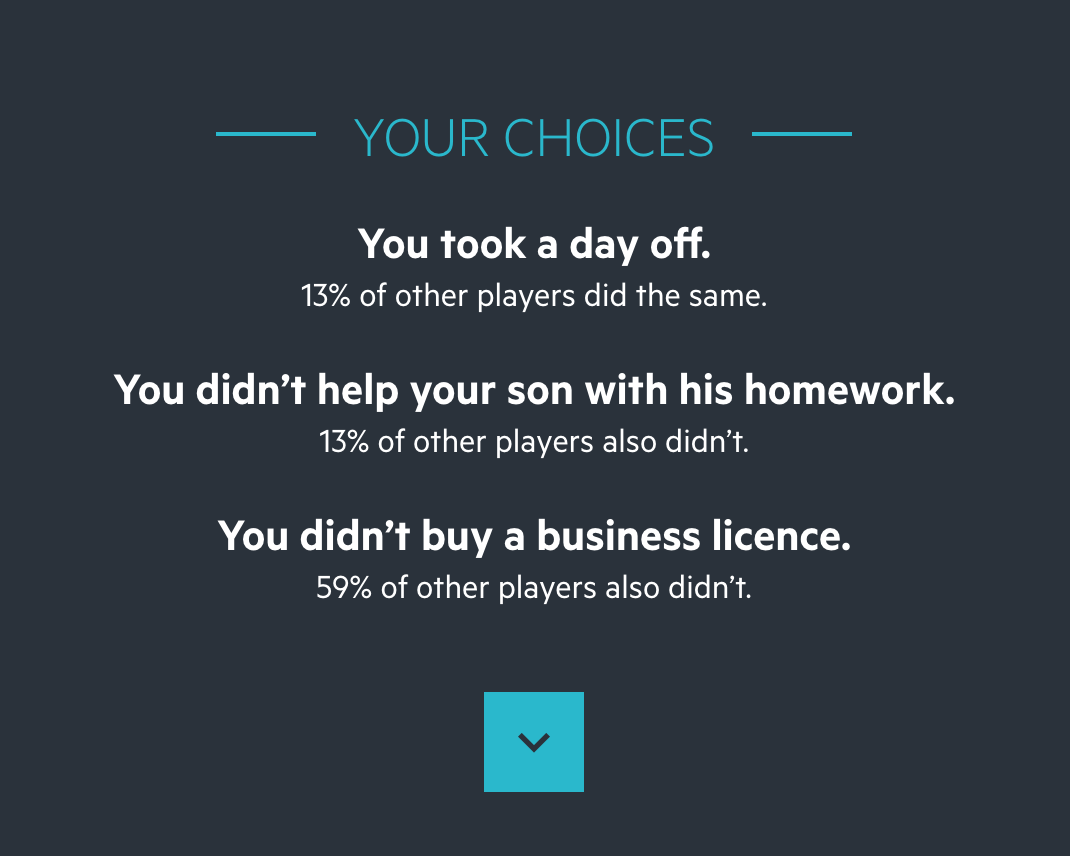Reflections on The Uber Game, one year on
A year ago, we published the Uber Game, a newsgame that puts players into the shoes of a full-time Uber driver. It was an exploration how interactive storytelling can be used in service of journalism — and an experiment in fostering curiosity about the news.
This past year has been a good one for the Uber Game. Besides quickly becoming one of the most read pieces of journalism published by the Financial Times in 2017, it has won a number of awards: at the Society of News Design, Online Journalism Awards, the Intenational Serious Play Awards and the Malofiej International Infographics Awards, and shortlisted at the Gerald Loeb and Data Journalism Awards.
Shortly after the game was published, our team wrote about the process of making it. I was interviewed, and gave presentations about the game. These opportunities for reflection mostly focussed on a particular aspect of making the game, or telling people about the immediate metrics of success (pageviews, completion rates, etc) we tracked.
With the benefit of some distance, I’d like to write a bit more about the less-proximate causes and effects of The Uber Game: my sources of inspiration, and some of the unexpected and more lasting outcomes.
Inspirations
These are things I’ve read, played, or otherwise studied before and during the making of The Uber Game. I owe a huge debt of gratitude to everyone mentioned here:
-
Nick Sousanis’s Unflattening (and our conversations), on how using new formats can bring new perspectives and challenge fixed viewpoints, and how text and imagery can come together in meaning-making
-
Bret Victor’s Magic Ink, on the use and purpose of graphical interfaces and interaction design.
-
Elizabeth Sampat’s Empathy Engines, on how games can foster connection, how systems make statements and mechanics are the message.
-
Celia Hodent’s The Gamer’s Brain (and her GDC talks and generous conversations with me) on UX design, motivation theory, and much more.
-
Kent Hudson’s The Novelist and GDC talk, on systems-based narrative design
-
Jonne Arjoranta’s Hermeneutic Challenge in King of Dragon Pass On how games can be used for developing cultural understanding
-
Raph Koster’s A Theory of Fun for Game Design, on what makes a game fun and why it matters
-
Meg Jayanth’s PRACTICE 2015 talk on 80 days, on re-examining the concept of ‘winning’, and unfairness in games.
-
Life is Strange and the Telltale Games (RIP) oeuvre - the ending sequence showing how the player’s choices compared to others draws direct inspiration from these two games.

-
Other games that inspired me: Bury Me, My Love, Reigns, Sunless Sea, Her Story, Coming out simulator, That dragon, Cancer
-
Alexis Kenndy, for our conversations and for reassuring me that my meagre programming knowledge and skill were enough to make something.
-
IDEO’s San Francisco office, for providing feedback on an early prototype of the Uber Game
-
The PRACTICE 2016 conference, where I presented what I was trying to do as an open problem and was blessed with thought-provoking answers. Thank you, Eric Zimmerman and Frank Lantz!
Outcomes
Beyond the pageviews and awards, here are a few things that have resulted from the Uber Game that I find particularly gratifying:
-
The Uber Game has been turned into an educational resource. Next Gen Personal Finance, a non-profit helping young people with their personal finance, created a worksheet for pupils to reflect on their experience after playing the game. Even months after the game was published we still occasionally saw traffic coming from classroom.google.com.
-
The Uber game is part of recent resurgence of newsgames, including Bloomberg’s American Mall game and ProPublica’s The Waiting Game. I’ve spoken to newsroom developers at other publications about games that they have made or are working on.
-
The Uber Game has helped those who have worked on it. Two members of our team, who have since left the FT for excellent jobs, both said that citing their work on the game helped land their new roles. Internally at the FT, the Uber Game is part of a broader move towards using other storytelling formats for journalism. For example, we recently commissioned and published a poem about Brexit and the Ireland border, presented as a beautifully shot video of the reading on the actual border.
What’s next for newsgames
I believe we’ll see more high quality newsgames made as one-off projects. But I think there is still a long way to go before newsgames become an established news format, or a class of content like video or audio. There is a big difference between making one good newsgame because everything happened to have come together in just the right way, versus being able to do so consistently at a high level.
Compared to other formats, newsgames remain complex and expensive to produce. This makes it hard to find sustainable business models to support and scale it beyond one-off or passion projects.
Instead, I think there is much more potential in deconstructing games like The Uber Game or American Mall to find small, specific bits of game mechanic or technique that could be widely applicable, even in non-game-like pieces of journalism. For example, best practices in writing branching narrative can be applied not just to choose-your-own-adventure type games, but also to scripting audio assistants and chatbots. ‘Social’ feedback showing how your choices compared to others are already fairly widely-used in interactive news. There’s potential in bringing more best practices from the world of game design to the world of interactive journalism.
What to read next: How (and Why) the Financial Times made The Uber Game